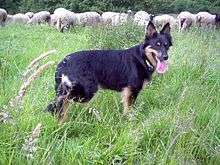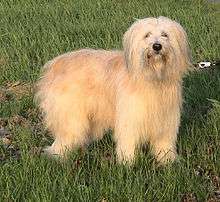Old German Herding Dogs
 Old German Shepherd Dog, landrace: east german Gelbbacke | |
| Other names | Altdeutsche Hütehunde; Altdeutsche Schäferhunde |
|---|---|
| Origin | Germany |
| Domestic dog (Canis lupus familiaris) | |
The Old German Herding Dogs (German: Altdeutsche Schäferhunde or Altdeutsche Hütehunde) are traditional types of working herding dogs from Germany. They are landraces consisting of working strains of dog, and some of them are the types from which the modern German Shepherd Dog was developed as a standardised breed. The landraces are not recognized by the Fédération Cynologique Internationale but have their own standards.[1]
History
Before the 1890s, any dog used for herding and protecting sheep in Germany was referred to as a "German Shepherd Dog". The dogs were bred solely for their working ability, with little effort to standardise a particular appearance, eliminate genetic defects or to create a defined breed of dog.[2]
In 1899 a new formal breed was established by the Society for the German Shepherd Dog. This was selected from amongst the working shepherd dogs,[3] and became the modern German Shepherd Dog breed.[4]
Many German herdsmen continued to breed their dogs for working ability rather than to the new breed standard, and their remaining non-standardised working dogs were called Altdeutscher Schäferhund, or "Old German Shepherd Dog".[3][5][6]
Under the Society for the German Shepherd Dog, the long-haired variant of the German Shepherd for a long time was not accepted. This changed in 2009.[7] Since 2010 the long-haired type has been accepted.[8] Previously, breeders of the long-haired variant of the German Shepherd had founded their own kennel clubs, and had called the long-haired variant the "Old German Shepherd Dog", too. So shepherds, farmers, and other owners of the threatened landraces had to find another name. They renamed the Altdeutschen Schäferhunde (Old German Shepherd Dogs) Altdeutsche Hütehunde (Old German Herding Dogs). Other old landraces of cattle dogs, which are not ancestors of the modern German Shepherd ( "zott"-coated dogs, cow dogs), were also given the generic name, Altdeutsche Hütehunde.
Appearance

It can be assumed that the today's Old German Herding Dogs differ scarcely from the landraces of the 19th and the early 20th century. Their breed standards require that the animal has to be capable of herding sheep and cattle but predescribes seldom the physical appearances. Though it's forbidden to cross-breed them with dogs of other breeds. In 2008, the German Society for the Conservation of Old and Endangered Livestock Breeds (GEH) listed the breed as "extremely vulnerable" to extinction.[9]
_1.jpg)

The landraces are divided, first after the cattle in cow dogs and sheep dogs, second in south German, east (middle) German and "zott"-hair-coated types and last in color types:
- Kuhhunde (cow dogs)
- Westerwälder
- Siegerländer
- Schafhunde (sheep dogs)
- Süddeutscher Typ (south german type)
- Süddeutsche Gelbbacke (south german "Yellow Cheek" - black and tan)
- Süddeutscher Schwarzer (south German "Black")
- Tiger (merle colored coat - often in south Germany, rarer elsewhere)
- Ost- bzw. Mitteldeutscher Typ (east or middle german type)
- Zotthaariger Typ (long and raw coated dogs similar to the Bobtail or Briard)
- Strobel (south German type)
- Schafpudel (German Sheeppoodle, north and middle German type)
- Süddeutscher Typ (south german type)
In the 19th century existed more of these landraces. Some of them became part of the breed of the German Shepherd and others became extinct by the course of time. The Pomeranian Sheepdog (Pommerscher Hütehund) and the Herding Spitz (Hütespitz) are to count the Old German Herding Dogs, too. They became extinct in the second half of the 20th century.[11] The Pomeranian Sheepdog was used to strengthen the Great Pyrenee, the Polski Owczarek Podhalanski, the Kuvasz and similar breeds.[12] It is often assumed that the last Herding Spitzes, which were mostly white and medium-sized,[13] became part of the breed of the White Shepherd.
References
- ↑ "Top-10-Fragen" (in German). AAH. Retrieved 2008-10-16.
- ↑ "A Profile of the German Shepherd Dog". Just Shepherds. Retrieved 2008-10-08.
- 1 2 "Altdeutscher Schaeferhund". Herding on the Web. Retrieved 2008-10-07.
- ↑ "History of the Breed". German Shepherds.com. Archived from the original on 2008-06-01. Retrieved 2008-07-15.
- ↑ von Stephanitz, Max; Schwabacher, Joseph (1994). The German Shepherd Dog in Word and Picture. Hoflin Publishing Ltd. p. 12. ISBN 978-99932-80-05-7.
- ↑ Willis, Malcolm; Bennett, Janet (1992). The German Shepherd Dog: A Genetic History. Maxwell Macmillan International. ISBN 0-87605-175-1.
- ↑ Die wichtigsten Beschlüsse der Bundesversammlung vom 6.-7. Juni in Kassel. In: SV-Zeitung. Juli 2009. S. 437–438.
- ↑ FCI-Standard N°166 - German Shepherd Dog (doc) "Double coat & long and harsher outer coat"
- ↑ "Westerwälder Kuhhund" (in German). German Society for the preservation of old and endangered breeds Association. Retrieved 2008-10-08.
- ↑ Beschreibung der Altdeutschen Hütehunde durch die Interessengemeinschaft Altdeutsche Hütehunde
- ↑ Linda Rorem in: The Old German Shepherd Dog in America on Herding on the web
- ↑ Erna Mohr in: Ungarische Hirtenhunde, second edition, Ziemsen, Wittenberg-Lutherstadt, 1969
- ↑ in 1951 were stated 57 centimetres at the withers and a weight of 23 kg for male dog by Wolfgang Luther: Beobachtungen über angeborene Verhaltensweisen bei einem pommerschen Hütehund. In: Zeitschrift für Tierpsychologie, 1951, Band 8, Heft 3, S. 443–448 doi:10.1111/j.1439-0310.1951.tb00185.x
| Wikimedia Commons has media related to Old German Herding Dogs. |